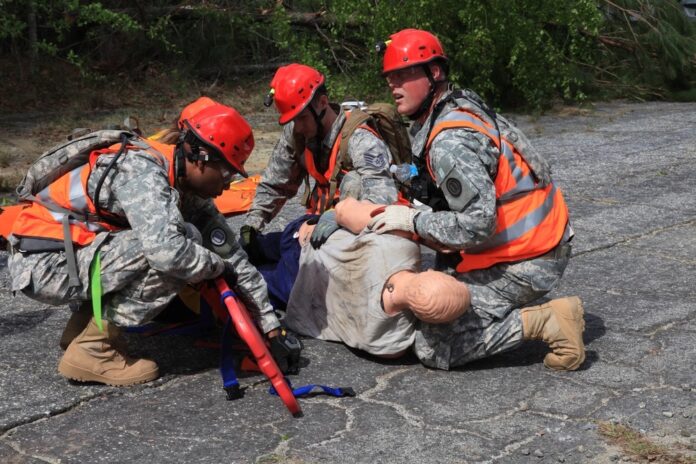In a mass casualty incident, minutes can often make the difference between life and death. The DARPA Triage Challenge (DTC) aims to drive breakthrough innovations that will enable medical personnel to respond effectively to mass casualty incidents (MCIs) in complex military and civilian settings, when medical resources are limited relative to the need. Specifically, DARPA sees opportunity in the identification of physiological features of injury, or “signatures,” that can be captured by stand-off and non-invasive contact sensors to help medical responders perform scalable, timely, and accurate triage. Competitors will participate in a series of events to spur identification of physiological signatures and development of sensor technologies for use in complex MCI settings.
Traumatic injuries suffered in diverse civilian and military settings such as combat, accidents, natural disasters, and attacks on gatherings may be fatal if not quickly identified and treated. Medical responders use triage procedures to rapidly prioritize casualties for immediate lifesaving interventions (LSIs), such as treatment of significant bleeding and management of airway threats. Triage is difficult in any circumstance, but MCIs in complex settings pose significant capability challenges. Overwhelmingly large numbers of casualties relative to medical resources on-hand; dangers to first-responders on the scene, such as unstable infrastructure, contaminants, or hostile fire; and environmental factors that make casualties harder to find and assess, such as rubble, flooding or darkness, may prolong the response. Further complicating triage is poor understanding of early physiological response to traumatic injury.
“Primary triage requires hands-on evaluation, which may be appropriate for a small number of patients, but does not scale to mass casualty incidents. In secondary triage, the standard approach is to periodically check vital signs, such as heart and respiratory rate, blood oxygen saturation, and blood pressure. These approaches may miss early indications of life-threatening injuries,” noted CDR Jean-Paul Chretien, the DARPA program manager for the effort. “The DARPA Triage Challenge seeks to enable medical responders to save lives in mass casualty incidents by exploiting stand-off sensors to rapidly and autonomously provide information needed in primary triage, and providing continued monitoring to predict need for life-saving interventions in secondary triage.”
The DARPA Triage Challenge is a three-year effort with three sequential 12-month phases for primary triage and secondary triage in parallel, each culminating in a challenge event.
The Challenge is organized into three competitions (Primary Triage-Real World, Primary Triage-Virtual, and Secondary Triage) with tracks for DARPA-funded and self-funded competitors. Prizes will be awarded to the top-performing teams in each challenge event based on eligibility, and competitors may participate in one or multiple competitions. Additionally, performers will collaborate with independent verification and validation teams and DARPA’s Research Infrastructure for Trauma with Medical Observations (RITMO) program, which provides data for use in the Secondary Triage competition.
The DTC’s long-term vision is:
- an initial, or primary stage of MCI triage supported by sensors on stand-off platforms, such as uncrewed aircraft vehicles or robots, and algorithms that analyze sensor data in real-time to allow medical personnel to identify casualties for urgent hands-on evaluation; followed by
- a secondary stage, after the most urgent casualties have been treated, supported by non-invasive contact sensors placed on casualties and algorithms that analyze sensor data in real-time to predict need for LSIs by medical personnel.
The notional DTC primary triage setting is the first few minutes of an MCI, with automated capture and processing of data from stand-off sensors to support medical responders in evaluating an overwhelming number of casualties. Competitors will be tested in physical or virtual simulations of MCIs. The notional DTC secondary triage setting is a casualty collection point, medical facility, or emergency department, after primary triage and immediate LSIs have been administered. In the secondary triage setting, patient status is further assessed and continuously monitored to identify changes requiring urgent intervention. Competitors will have access to de-identified clinical data from DARPA’s RITMO program for use during the competition.
In an eventual application, these sensors would provide injury information for integration with other data about the scene to enhance overall situational awareness, and focus further physiological interrogations, as evidence accumulates about injury mechanism and characteristics.
“The DARPA Triage Challenge will gather communities with expertise in triage and emergency medical response, tactical combat casualty care, trauma physiology, and a diverse array of physiological signatures and sensor and algorithm technologies that will continue to deliver innovative technologies that support medical responders beyond the Challenge,” added Chretien.
A Proposers Day virtual event is scheduled for November 29, 2022. Registration is required by November 23. For more details and to register, visit: https://events.sa-meetings.com/DTCInformationDay.
For teams interested in applying for funding, proposals are due February 13, 2023, and the first of three annual challenge events will be held fall 2024. Additional details on the Challenge, and associated prizes, are available in a forthcoming broad agency announcement (BAA) and on the Challenge website: https://triagechallenge.darpa.mil/.




